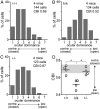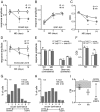Dendritic BDNF synthesis is required for late-phase spine maturation and recovery of cortical responses following sensory deprivation
- PMID: 22492034
- PMCID: PMC3356781
- DOI: 10.1523/JNEUROSCI.4462-11.2012
Dendritic BDNF synthesis is required for late-phase spine maturation and recovery of cortical responses following sensory deprivation
Abstract
Sensory experience in early postnatal life shapes neuronal connections in the brain. Here we report that the local synthesis of brain-derived neurotrophic factor (BDNF) in dendrites plays an important role in this process. We found that dendritic spines of layer 2/3 pyramidal neurons of the visual cortex in mutant mice lacking dendritic Bdnf mRNA and thus local BDNF synthesis were normal at 3 weeks of age, but thinner, longer, and more closely spaced (morphological features of immaturity) at 4 months of age than in wild-type (WT) littermates. Layer 2/3 of the visual cortex in these mutant animals also had fewer GABAergic presynaptic terminals at both ages. The overall size and shape of dendritic arbors were, however, similar in mutant and WT mice at both ages. By using optical imaging of intrinsic signals and single-unit recordings, we found that mutant animals failed to recover cortical responsiveness following monocular deprivation (MD) during the critical period, although they displayed normally the competitive loss of responsiveness to an eye briefly deprived of vision. Furthermore, MD still induced a loss of responsiveness to the closed eye in adult mutant mice, but not in adult WT mice. These results indicate that dendritic BDNF synthesis is required for spine pruning, late-phase spine maturation, and recovery of cortical responsiveness following sensory deprivation. They also suggest that maturation of dendritic spines is required for the maintenance of cortical responsiveness following sensory deprivation in adulthood.
Figures










Similar articles
-
Monocular deprivation induces dendritic spine elimination in the developing mouse visual cortex.Sci Rep. 2017 Jul 10;7(1):4977. doi: 10.1038/s41598-017-05337-6. Sci Rep. 2017. PMID: 28694464 Free PMC article.
-
Distinct roles for somatically and dendritically synthesized brain-derived neurotrophic factor in morphogenesis of dendritic spines.J Neurosci. 2013 Jul 10;33(28):11618-32. doi: 10.1523/JNEUROSCI.0012-13.2013. J Neurosci. 2013. PMID: 23843530 Free PMC article.
-
Early Sensory Loss Alters the Dendritic Branching and Spine Density of Supragranular Pyramidal Neurons in Rodent Primary Sensory Cortices.Front Neural Circuits. 2019 Sep 25;13:61. doi: 10.3389/fncir.2019.00061. eCollection 2019. Front Neural Circuits. 2019. PMID: 31611778 Free PMC article.
-
Experience-dependent pruning of dendritic spines in visual cortex by tissue plasminogen activator.Neuron. 2004 Dec 16;44(6):1031-41. doi: 10.1016/j.neuron.2004.11.028. Neuron. 2004. PMID: 15603745
-
Local effects of BDNF on dendritic growth.Rev Neurosci. 2004;15(2):117-29. doi: 10.1515/revneuro.2004.15.2.117. Rev Neurosci. 2004. PMID: 15202684 Review.
Cited by
-
Genetic evidence that brain-derived neurotrophic factor mediates competitive interactions between individual cortical neurons.Proc Natl Acad Sci U S A. 2012 Nov 20;109(47):19456-61. doi: 10.1073/pnas.1206492109. Epub 2012 Nov 5. Proc Natl Acad Sci U S A. 2012. PMID: 23129644 Free PMC article.
-
Mice deficient in phosphodiesterase-4A display anxiogenic-like behavior.Psychopharmacology (Berl). 2014 Aug;231(15):2941-54. doi: 10.1007/s00213-014-3480-y. Epub 2014 Feb 22. Psychopharmacology (Berl). 2014. PMID: 24563185
-
Monocular deprivation induces dendritic spine elimination in the developing mouse visual cortex.Sci Rep. 2017 Jul 10;7(1):4977. doi: 10.1038/s41598-017-05337-6. Sci Rep. 2017. PMID: 28694464 Free PMC article.
-
Brain-Derived Neurotrophic Factor: Three Ligands, Many Actions.Trans Am Clin Climatol Assoc. 2015;126:9-19. Trans Am Clin Climatol Assoc. 2015. PMID: 26330656 Free PMC article. Review.
-
Neuropeptide transmission in brain circuits.Neuron. 2012 Oct 4;76(1):98-115. doi: 10.1016/j.neuron.2012.09.014. Neuron. 2012. PMID: 23040809 Free PMC article. Review.
References
-
- Barthó P, Hirase H, Monconduit L, Zugaro M, Harris KD, Buzsáki G. Characterization of neocortical principal cells and interneurons by network interactions and extracellular features. J Neurophysiol. 2004;92:600–608. - PubMed
-
- Bartoletti A, Cancedda L, Reid SW, Tessarollo L, Porciatti V, Pizzorusso T, Maffei L. Heterozygous knock-out mice for brain-derived neurotrophic factor show a pathway-specific impairment of long-term potentiation but normal critical period for monocular deprivation. J Neurosci. 2002;22:10072–10077. - PMC - PubMed
-
- Cabelli RJ, Hohn A, Shatz CJ. Inhibition of ocular dominance column formation by infusion of NT-4/5 or BDNF. Science. 1995;267:1662–1666. - PubMed
Publication types
MeSH terms
Substances
Grants and funding
LinkOut - more resources
Full Text Sources
Molecular Biology Databases
